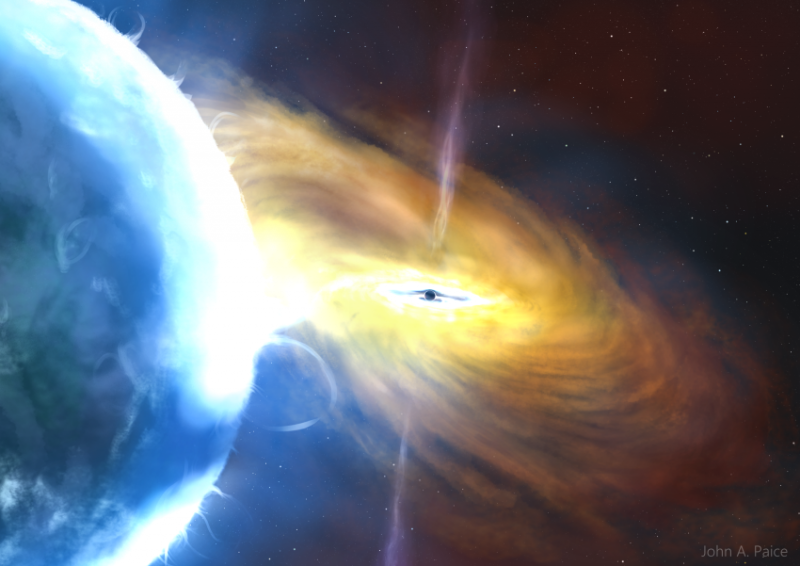
Largest cosmic explosion ever seen
On May 11, 2023, the Royal Astronomical Society announced that a team of astronomers has found the largest cosmic explosion ever seen. Shining 10 times brighter than any known supernova. The explosion, dubbed AT2021lwx, has lasted for more than three years. (Whereas most supernovas are only bright for a few months.) The gargantuan explosion was most likely the result of a black hole ripping apart a cloud of gas that’s thousands of times larger than our sun. AT2021lwx lies 8 billion light-years away in the direction of the constellation Vulpecula. The universe was around 6 billion years old when AT2021lwx erupted in violence.
The team of astronomers, led by the University of Southampton, published their peer-reviewed study in the journal Monthly Notices of the Royal Astronomical Society on April 11, 2023.
Discovery of the largest cosmic explosion
The astronomers first found the explosion in 2020 data from the Zwicky Transient Facility in California. Next, the Asteroid Terrestrial-impact Last Alert System (ATLAS) based in Hawaii picked up the explosion. Then the team observed the explosion with three more telescopes: the Neil Gehrels Swift Observatory in space, the New Technology Telescope in Chile, and the Gran Telescopio Canarias in La Palma, Spain.
Lead author Philip Wiseman of the University of Southampton explained:
We came upon this by chance, as it was flagged by our search algorithm when we were searching for a type of supernova. Most supernovas and tidal disruption events only last for a couple of months before fading away. For something to be bright for two plus years was immediately very unusual.
Team member Sebastian Hönig of the University of Southampton explained how the team realized it was special:
Once you know the distance to the object and how bright it appears to us, you can calculate the brightness of the object at its source. Once we’d performed those calculations, we realized this is extremely bright.
What is AT2021lwx?
AT2021lwx is the largest explosion astronomers have yet seen. They believe it was the result of a large cloud of gas interacting with a black hole. The press release said:
Fragments of the cloud would have been swallowed up, sending shockwaves through its remnants, as well as into a large dusty doughnut-shaped formation surrounding the black hole.
This is the first time astronomers have seen this kind of explosion on such a massive scale. For comparison, in 2022 astronomers saw the brightest gamma-ray burst on record. Its brightness outshone AT2021lwx, but for just a fraction of time. AT2021lwx’s ongoing explosion means it has much higher energy overall. The scientists said that the physical explosion is about 100 times larger than our solar system. The explosion peaked at about 2 trillion times brighter than our sun.
The closest comparison to objects this bright in the universe are quasars. Quasars are supermassive black holes at the centers of galaxies feeding on accretion disks.
Team member Mark Sullivan, also of the University of Southampton, explained the difference between quasars and the newly discovered explosion:
With a quasar, we see the brightness flickering up and down over time. But looking back over a decade there was no detection of AT2021lwx, then it suddenly appeared as one of the most luminous things in the universe, which is unprecedented.
The future of the research
The team is still gathering more data on the explosion. They want to learn about AT2021lwx in different wavelengths, including X-rays. The X-ray data could help them understand the temperature of the explosion and what might be happening on the surface. Wiseman said:
With new facilities, like the Vera Rubin Observatory’s Legacy Survey of Space and Time, coming online in the next few years, we are hoping to discover more events like this and learn more about them. It could be that these events, although extremely rare, are so energetic that they are key parts of how the centers of galaxies change over time.
Bottom line: Astronomers have found the largest cosmic explosion yet seen. They believe it comes from a cloud of dust around a black hole that was 10 times brighter than any supernova. So far the explosion has lasted more than 3 years.
Source: Multiwavelength observations of the extraordinary accretion event AT2021lwx
Via Royal Astronomical Society
The post Largest cosmic explosion ever seen is still ongoing first appeared on EarthSky.
0 Commentaires